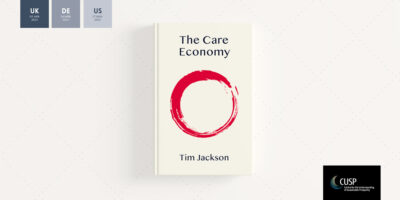Healthy organizations: transforming business to contribute to a sustainable society
What role can businesses play in helping to mitigate the global crises across climate, nature and social justice? And what would that mean for their employees, leaders, stakeholders and those that seek to support them? In this blog, Ben Kellard and colleagues are exploring options through the lens of ‘health’.
Blog by BEN KELLARD et al

As decisions are reached at COP26 on the future of a low carbon economy, there is a pressing need to understand how businesses can support the wider transition to a sustainable future, both for those leading and advising businesses. As the pandemic has amply demonstrated, health is a central element of prosperity and well-being, and is central to sustainable economies.
A dozen practitioners came together in October with a shared sense of urgency and interest in exploring the potent role organizations can play in society by clarifying their ‘why’ and taking bold steps to cultivate a sustainable purpose. This is to the backdrop of interconnected global crises across climate, nature and social inequality. So what role might businesses play and what does this mean for their employees, leaders, stakeholders and those that seek to support them?
What follows is a high-level summary of insights that emerged through a series of dialogues, together with signposts to relevant literature. The aim here is to summarize and share the main insights and unresolved questions that emerged from this group of practitioners, to contribute to the debate on the role of business in society.
1. Healthy organizations as living ecosystems
Through our dialogues, health emerged as a powerful lens through which to see not just organizations, but the people they serve and work for them as well as the wider economy, society and planet in which they operate. The concept of planetary health explores health, wellbeing, and equity worldwide as well as the state of the natural systems on which human health and ultimately our survival depends (The Commission on Planetary Health.) This permits a holistic approach to viewing an organization as a healthy, living eco-system of many participants. It reflects the connections and reciprocity between the networks, or ecosystem, that enables and supports the health of the organization. Each is reliant on the health of the other.
Health also implies evolution that captures ongoing innovation and renewal, as opposed to growth for growth’s sake. Health suggests an organization thrives by finding its optimal size and shape, given its role in the wider ecosystem, or society. It suggests a type of growth that supports the health of the wider ecosystem in the process.
Business can contribute to unlocking this potential by having a corporate purpose that finds the intersection between how it serves society (within social and natural constraints) and thereby makes a surplus (or profit). As people are essentially social and purpose-driven, companies whose purpose is profit-maximisation risk dislocating themselves from society and stakeholders. They may be by focusing on a means, rather than an end that is meaningful in and of itself. In his book Growing the Pie, Alex Edmans suggests companies should increase the value they create for society, thereby ‘growing the pie’ for both the business, investors and society.
How do we shape organizational purposes that are healthy, meaningful and connect with stakeholders? How do we prevent the potential of a healthy, sustainable organizational purpose becoming hollowed out?
As companies are starting to understand their climate impacts across scopes one to three we ask how might organizations diagnose their health,? Richard Hardyment has taken an evidence-based approach to exploring how organizations can promote wellbeing across its value chain, in his book Wellbeing Purpose. How can organizations demonstrate and disclose their contribution to a healthy society and nature, both quantitatively and qualitatively? Boards then become the trustees of the organization’s purpose. This builds on the evolving role of Corporate Governance.
2. Healthy teams and colleagues
An organizational purpose that promotes a healthy society and planet allows employees to align their personal passion and purpose with that of the organization. When combined with a culture where people are cared for and seen as ‘a someone not a something’, it can attract and motivate employees, recognizing that responsibility can only be taken, not given. In this way, a health-promoting purpose connects with people’s desire and aspirations, as opposed to a sense of duty. An employee’s engagement and alignment with the purpose will test the extent to which the purpose is clear, owned by the employee and the culture is such that they feel valued, safe and empowered to act upon it.
Health also allows employees to recognize that the organizational change often requires grief and healing. Changes are required to adapt to new contexts or recover from pursuing an organizational purpose that is a means, not an end.
An employee’s engagement in the purpose also distinguishes between purposefulness—that is dynamic, and the purpose statement itself—that is static. The above can equally be applied to teams as they make sense of and own the purpose for themselves and their context.
The implication is that the centre of gravity or ownership of the corporate purpose shifts from the corporate centre and executive team to the wider organization. This decentralisation of power becomes an invisible form of leadership that is shared by employees and teams. This de-centralization of power is explored in Matthew Barzun’s book ‘The Power of Giving Away Power; how the best leaders learn to let go‘.
What is the role of informal governance that creates common ground around the purpose that enables a flexible and inclusive culture? How else can the culture enable employees (and other stakeholders) to connect their personal ‘why’, with that of the organization? How do we measure performance without it becoming surveillance that undermines trust and autonomy?
3. Healthy leadership
Leadership within a healthy organization recognizes the importance of connections between internal and external stakeholders, i.e. the wider ecosystem, and that the organization’s health is reliant upon their health. This reciprocity also values vulnerability and its ability to build connections, surface insights and build trust with others. A healthy leader is likely to bring curiosity and humility to explore connections, implications and opportunities. This will be done best with others, using dialogic methods to co-create solutions with other stakeholders. Mary Parker Follett shows the importance of interpersonal relations in collective problem solving.
This approach recognizes that many problems faced today are complex, uncertain, fragmented and require multiple viewpoints to optimize the way forward. Matthew Syed’s book ‘Rebel Ideas‘ identifies the need for collective ‘cognitive diversity’ to solve complex challenges we face today. Writers such as David Bohm and Martin Buber have contributed significantly to the field of dialogue and its potential to respond to fragmentation by creating shared meaning, including responding to different viewpoints and being changed by them.
Such a take on leadership contrasts with the view of a leader as someone that is in control, oversees everything, fixes problems and always has the ‘right answer’. Leaders steeped in this rather conventional understanding of leadership may be encouraged to explore and shift to more ‘healthy’ forms of leadership by connecting directly with nature, to recognize its inherent value, or being asked questions about how their passions and values might connect with the challenges faced by the world.
What more is needed to progress the diversity conversation from identity (race, age, and gender) to cognition (differing viewpoints, alternative frames of reference)? How else might conventional leaders be inspired to promote healthier forms of leadership and organizations? Have our needs from leadership now evolved beyond the requirement for hero leaders, to servant leaders?
4. Healthy ecosystems
Healthy organizations recognize their interdependence with other stakeholders and see it as being in their interests to ensure a healthy society, economy and planet. This involves being aware of and investing in the quality of connections and dependencies with external stakeholders with whom they have a reciprocal relationship and shared interest in the health of the ecosystems. These connections could be positive or negative impacts the business has on nature and society (often referred to as externalities), or inputs into the business’s value chain, such as raw materials or pools of labour. This views the organization as part of an ecosystem or network of stakeholders (some of which, like nature, are silent, invisible and mobile) on which it depends on a sustained and reciprocal flow of various forms of value between them. As well as nature, stakeholders could include suppliers, customers, local communities, investors or regulators.
A healthy ecosystem is made up of a diversity of sectors and organizations from public and third sector to small and large businesses that serve civil society.
How do we support different sectors and sizes of organizations, to become more healthy and to develop an equal regard for the health of the planet upon which their enterprise depends? What are their respective roles in creating healthy ecosystems? Is there a role for a healthy purpose movement? What are the potential head and tailwinds?
What is the role of technology in the creation of healthy organizations and society? Digital with Purpose is a movement and framework to enable tech companies to integrate the delivery of the SDGS within their strategy and purpose.
5. Healthy practitioners
Ed Gillespie’s article on the risk of advisors colluding with and covering for clients that aren’t serving society, presents a challenge to advisors and practitioners seeking to help organizations to become healthy. Practitioners, like leaders, are caught in the gap between the negative impacts of organizations today and where they need to be to deliver the UN SDGs and Paris Agreement. This requires an unapologetic boldness to both challenge and guide organizations to find a healthy role in society, given the urgency with which we collectively face the future.
How do leaders and practitioners see and avoid this collusion and promote the potential of healthy organizations, within environmental and social limits? The following approaches can assist practitioners to play their role and avoid collusion:
- There is always the risk of blind spots, for both clients and practitioners. Using the latest science and evidence to raise awareness and inform ambition and action can help. Self-awareness and curiosity become important attributes of a practitioner.
- Bill Sharp’s work on the Three Horizons uses a foresight framework for thinking about the speed of innovation needed over different time horizons. It can help practitioners and clients align on the speed and extent of transformation required, especially when combined with evidence-based goals.
- Dialogue with diverse groups can also help to bring multiple spheres of knowledge together (including stakeholders that represent the ecosystem) and surface blind spots. Dialogue can also help to build a richer view of the organization’s context, ecosystem, stakeholders, connections and options. Together, new solutions can emerge.
- Like leaders, practitioners are not there to tell the organization what to do or come up with the ‘right answer’ or purpose. Rather, like Socrates, they can act as a midwife, helping the organization to find its own path. This may involve a combination of challenging and guiding the client to come to an informed and shared way forward.
- Practitioners can also use stories to capture the lessons of other organizations and capture principle-based guides to help organizations navigate and adapt good practices to their own context.
- A positive narrative that creatively captures the benefits of being healthy in language that people can connect with can also help to inspire people around a shared aspiration.
- Professional services firms can also go on their own journey by asking what their role and purpose in society is. This can help them to build insights and clarify how they can serve what type of clients.
- Practitioners can also share insights, challenge and support one another as they find their own way to build a healthier society.
It is in this spirit that we humbly share these insights with the intention of contributing to the field and this important, on-going dialogue.
This health lens on organizations may carry challenges, opportunities and questions for different stakeholder groups, such as:
- Organizational leaders—does your leadership style and view of organizations contribute to creating a healthy organization and its wider ecosystem?
- Advisors—does your practice, services and organizational purpose enable and promote healthy organizations?
- Academics—does your research provide the clarity, guidance and evidence for healthy organizations?
- Investors—are you investing in and actively engaging with companies to become healthier and requiring them to disclose their performance?
- Regulators—does regulation support and incentivise the creation of healthy organizations and their disclosure?
Given the urgent need to transform our economy, businesses have a key role to play. Seeing businesses as part of healthy ecosystems may help to unlock a business’ potential to deliver positive impact for themselves, their stakeholders and society.
. . .
This blog was written by Ben Kellard with input from attendees of the dialogues: Murray Brown, Vittorio Cerulli, Frederick Dahlmann, Neil Gaught, Fergus Lyon, Victoria Morton, Hugh Pidgeon, John Rosling, Thomas Vergunst, Andrew Wilson, Charles Wookey.



